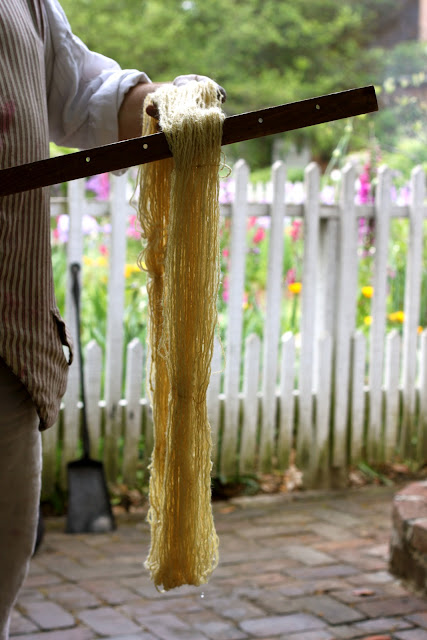My heart throb and I celebrated eight years of marriage with a trip to Williamsburg recently. If you've never been, Colonial Williamsburg is a living history museum. It's 301 acres of land with tons of restored and furnished 18th century buildings. There are costumed interpreters of history telling us what life was like in that town on the cusp of the Revolution. (Williamsburg was once Britian's largest and wealthiest outpost of empire in the New World.)
There are also over nineteen different types of trades and crafts practiced on site using the 18th century methods. That's where my heart really started racing... I loved getting to see all of these tradespeople. The cabinet makers were doing woodworking with tools made just down the street at the blacksmith's shop! It's a working town that sustains its self with items made by the craftspeople who work there.
All the while I'm getting to look at this view... nice! :)
I asked a million and one questions while I was there, maybe too many? I got myself into a little bit of trouble. What can I say?
My favorite spot was talking with the weaver. In the 18th century, most of the cloth used was imported, but when embargoes ban imported cloth the weavers became very important. They would spin the yarn on site using wool or cotton.They would weave the yarn into dish cloths or table runners or even windmill sails using this cantilever loom (which was made by the cabinet shop on site... duh! That in itself was a total work of art.)
Now let me share a little bit of my ignorance. I've always pictured the colonists walking around in gray and white, black or maybe brown. Oh no, my friends, they wore way more bold colors than you would expect!
The gorgeous colors they would wear came from nature... walnuts (brown), cochineal bugs from South America (red), indigo from South Carolina (blue), Spanish log wood tree (purple), Madder plant root (orange) and turmeric from India (yellow).We had the privilege of watching weaver Max Hamrick dye green yarn. Green is special. A weaver may apprentice for seven years before he finally mastered the art of dying yarn green. The process is difficult because it is an over dye. First, the yarn is dyed the perfect shade of yellow and allowed to dry, then it is submerged for the perfect amount of time in a cauldron of blue dye, rinsed and allowed to dry.
When it is first pulled out of the cauldron oxidation takes place right before our eyes and the yarn slowly turns colors as it is exposed to the air.
And that is the closest I get to enjoying chemistry!
They seem to love it though. It takes a special person to keep trades like this alive all while wearing period dress and answering the millions of questions from pesky onlookers like myself. I love how passionate they are about history and their craft. It makes me want to set up a cauldron in my front yard and go to town dying some yarn. I wonder if the Homeowners Association would be cool with that?!













4 comments:
Great pictures & a nice informational post! I was just talking about Williamsburg yesterday! I really would like to make it back there, as my 15 year old self didn't appreciate all its glory! Great pictures!
...and I just realized every sentence of mine ended with an exclamation point. Apologies for the overuse; this post made me really excited. :)
this is just the coolest! love that pic of you in the stocks ;) what'd ya do!?! you're always getting arrested...it's kinda embarassing being your friends sometimes ;) we are going to williamsburg..sometime...needs to make some plans! you made me want to go even more!!
I love Williamsburg and visit at least once a year! We spent a good bit of time watching Max dyeing when we were last there in April. He is working on a book, which I think should just about be done by now.
Post a Comment